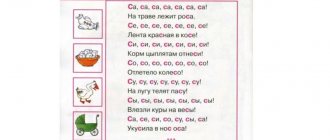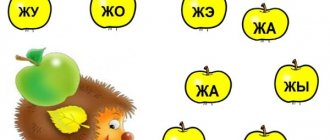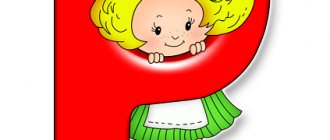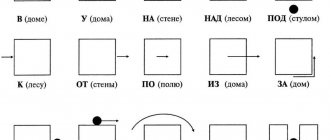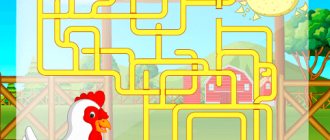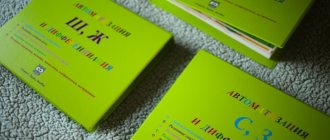Among the back-lingual phonemes, the articulatory structure of the sound [K] is considered basic. Automation of [K] in syllables and syllables, in coherent speech is impossible without mastery of correct articulation.
When playing [K] and [G], the lips open slightly and remain in a neutral position. The teeth are slightly open. The tip of the tongue is located at the lower incisors. The front and middle parts of the back are freely lowered, the back part rests against the soft palate, which, rising, is pressed against the posterior pharyngeal wall. The sides slightly touch the back of the hard palate. The air flow breaks through the closure between the back of the lingual dorsum and the soft palate.
When articulating [K], the vocal cords relax and move apart, the voice is not involved. When articulating [G], they combine to create a voice. Sound [K] - consonant, hard, dull. The sound [G] is consonant, hard, sonorous.
Any deviation from the articulatory position described above that does not result in a defective sound is not considered an abnormality.
Violation of the pronunciation of the sound [K] is called kappacism. Replacing it with another sound, often with [T] or [X], is called paracappacism. Defective pronunciation of the sound [G] is called gammacism. Replacing [G] with the phoneme [D] is called paragammatism. The most common violation of the pronunciation of these phonemes is their elision (omission).
If the reproduction of phonemes is defective, work on their production is required. To correct [K], the speech therapist gives the task to bend the tongue into a mound, press it firmly to the palate and blow away a light object lying on the hand near the child’s mouth. The sound [K] is heard. By repeating an action many times, you can automate the articulatory position of the sound.
Another technique for setting [K] is to induce a slight cough. To set [G], a tactile vibration technique from the reference phoneme [K] is used. One of the child’s hands is on the speech therapist’s larynx, and the other is on his own. The child says [K] and notes that the vocal folds do not vibrate during articulation. Next, the child is asked to connect his voice and say [K] loudly. You should hear [K].
Articulation of the sound G
The articulation of the sound [G] is the same as that of the sound [K], only with the participation of the voice. The lips are neutral and take the position of the next vowel. The teeth are open. The tip of the tongue is lowered and touches the lower incisors. The lateral edges of the tongue are pressed against the upper back teeth. The back of the tongue forms a bridge with the palate. The soft palate rises and closes the passage into the nasal cavity. The vocal folds are open. The exhaled stream explodes the bridge between the tongue and the palate, resulting in a characteristic sound. The vocal folds close and vibrate.
Automation of the G sound in syllables
In this exercise, the child is asked to listen, remember and pronounce various syllables and their sequential combinations. The transition from simple to complex is observed.
Combination of G with vowel sounds:
- ha-ha;
- ho-ho;
- goo-goo;
- ga-go-gu;
- uh-huh-uh-huh.
Syllables involving other consonants:
- gwa-gwo-gwu;
- gla-glo-gloo;
- sga-sgo-sgu;
- rga-rgo-rgu.
For G' (soft sound):
- ge-ge;
- gi-gi;
- gli-gli-gli;
- gree-gree-grie.
Automation of the sound [G] at the beginning of words with merging consonants
Repeat the words clearly, emphasizing the sound [g] in your voice.
drive bend anger bend nest
rook pear loud mane mushrooms
nails wilderness clay gloss glaze
depth eye gladiolus edge thunder penny load mushroom
make-up vulture gram milk mushroom primer
pear letter engraver rodent comb
We ALWAYS explain all words that a child does not understand!!!
Automation of sounds with neurostimulation techniques. Automation of the sound "C"
The methodological manual is devoted to techniques for automating the sound C and introducing it into speech in cases of erased dysarthria. Automation of sounds and their introduction into speech is the most difficult aspect of a speech therapist’s work with a child with erased dysarthria. All speech therapists have encountered these difficulties.
The manual will reveal the theoretical and practical essence of tactile-kinesthetic stimulation, bioenergoplasty, kinesitherapy, as ways to overcome long-term automation in erased dysarthria. Neurostimulation techniques for automating sounds will be discussed, and the secrets of innovative techniques for the process of automating sounds for dysarthria will be revealed. The manual covers practical techniques that have been tested by experience and time. material illustrating all stages of sound automation C.
The stage of sound automation is the consolidation of conditioned reflex speech-motor connections on lexical material of varying complexity until the skill is fully strengthened.
Motor programming is included in the general program of speech action and is realized in the speech act. The quality of this implementation depends on skill. A skill is an automated component of conscious activity that arose as a result of exercise, a fixed method of action.
Skill as a way of strengthened implementation of speech action is closely related to the articulatory base. A skill is determined by experience, in this case speech experience, which is not only supported by conditioned reflex connections, but also leads to the emergence of a speech mechanism, or speech ability. This mechanism is formed in each person on the basis of the innate psychological characteristics of the body and under the influence of verbal communication. For a lasting skill, long-term exercises are needed, which are gradually formed from knowledge and skills to a fixed automatism - a skill. Knowledge and skills are formed through exercises and create the opportunity to perform actions not only in familiar conditions, but also in changed ones.
With erased dysarthria, defective articulatory skills are noted, formed as a pathological stereotype. The speech therapist is faced with the task of weakening and extinguishing defective articulation skills. Therefore, the process of developing new skills and abilities during correctional training is fundamental in the work of a speech therapist.
Children with erased dysarthria have incorrect stereotypes of pronunciation of sounds in various speech materials. Therefore, automation of sound requires the active use of the process of internal inhibition, the ability to differentiate correct and incorrect articulation patterns. It is carried out according to the principle “from simple to complex.”
First of all, the inclusion of sound in syllables is carried out. A syllable is the simplest speech unit. Syllables do not matter, and the child, therefore, does not have stereotypes in the pronunciation of syllables, and this facilitates their automation.
When incorporating automated sound into words, it is necessary to provide for a number of requirements for lexical material. Firstly, it should contain the maximum number of sounds that can be assigned. Secondly, it should not contain sounds that the child pronounces incorrectly. Thirdly, it is necessary to take into account the semantic accessibility of lexical material. When including new words, it is necessary to clarify the semantics (meaning) of the words, which will expand the child’s passive vocabulary.
Before revealing the author's innovative automation techniques, we want to give historical aspects of sound correction and automation.
Historical aspects of sound correction and automation
In classical speech therapy, when correcting sound pronunciation, the recommendations of M.E. are used. Khvattseva. During initial automation, the sound should be at the beginning of the word under stress. In such positions, sounds are more easily automated. Then children learn to pronounce sounds in any combination.
Continuing the traditions of classical speech therapy, M.F. Fomicheva clarified that sounds in speech are not used in isolation. You should start automating sound with straight syllables, because the child has the opportunity to create the desired consonant articule and move to the vowel. First, a straight syllable with a vowel [a] is given, since when pronouncing it the lips are in a neutral position, the mouth is wide open, the tongue is in a lower position, which does not interfere with the articulation of the automated sound. Then they automate the sound with the vowel [s]. This is also a non-labialized sound and has less influence on the previous consonant. Next are syllables with [o] and [y]. Straight syllables in combination of a consonant with a vowel [e] are usually not used, because they are not typical for the Russian language and are found mainly in borrowed words (“mayor”, “sir”, etc.). The sound is then fixed in reverse syllables. Next, it is recommended to fix the sound in an intervocalic position (between two vowels) and, finally, in syllables with a consonant cluster.
In accordance with this sequence, to automate the sound in words, the corresponding lexical material is selected (words with the syllables SG, GS, GSG, SSG, GSS, etc.). The place of sound in a word also matters. The following sequence of automation is recommended: first, the sound is fixed at the beginning of the word (before the vowel), then at the end (if the sound is dull), then in the middle, because this position turns out to be the most difficult. First, the sound is automated in words with a simple syllabic structure, then in words of a more complex syllabic structure containing a combination of this sound with correctly pronounced sounds. Consolidation of sounds in sentences is carried out on the basis of worked words in the same sequence.
Certain requirements are imposed on lexical material in relation to semantics. Speech material (words, phrases) should be accessible to the child and, if possible, borrowed from everyday life, and then a vocabulary that is more complex in semantics is used.
A certain sequence for automation was proposed by G.V. Gurovets and S.I. Mayevskaya. Lexical material for consolidating sounds should be selected taking into account the gradual increase in the syllabic complexity of the word. It is proposed to first introduce sound into two-syllable and then into three-syllable words with straight syllables. Then they move on to words with a reverse syllable. And then they move on to one-syllable and two-syllable words with a combination of consonants at the beginning of the word. Gradually, words with fixed sounds are introduced into the phrase in other contexts.
When selecting lexical material for automating sounds, especially words with a combination of consonants, one should take into account the data of A.K. Markova about the sequence of appearance of sound combinations in ontogenesis. A.K. Markova determined the following sequence.
In the middle of the word: [nt, xt, kb, mp, dl, kt, gd, pl, tk, kt, st, tl, lk, pt].
At the beginning of the word: [gr, cr, sun, dv, dl, pl, vm, dn, gn].
The issue of automation of sounds was also developed by E.F. Sobotovich. It was noted that insufficient attention is paid to techniques for reinforcing correct sound pronunciation in spontaneous speech. Speech therapy work comes down to developing the correct pronunciation of defective sounds in various types of syllables and sound combinations, then in words, sentences and various types of expanded speech. In parallel with this, work is being done to differentiate mixed sounds. This scheme, without any significant changes, is used to correct any phonetic disorders, i.e. when the phonetic defect is the only defect in the child’s entire speech and when the phonetic disorder is part of the structure of a defect in a more complex speech pathology.
Experimental studies by E.F. Sobotovich showed that the process of forming and consolidating the correct pronunciation of sounds in words proceeds differently in children with the same types of sound pronunciation disorders. A correlation was discovered between the process of restructuring sound pronunciation skills, automation and their level of general speech development.
In children with a high and normal level of speech formation, automation processes in any variant of the phonetic context proceed without difficulty. In children with a low level of speech formation, due to insufficiently formed phonemic hearing, automation is difficult. It is emphasized that the process of perception and pronunciation of individual sounds and simple syllable combinations is largely more elementary compared to the process of forming and consolidating the correct pronunciation of words. Consequently, the perception of sounds included in a word and their correct placement within a word depends on the level of development of phonemic hearing. This determines the leading role of phonemic hearing in the process of sound automation.
A necessary condition for successful sound automation, according to T.B. Filicheva, is a gradual and systematic increase in the tempo of speech exercises. The requirement to adhere to strict consistency when working on sound automation involves a gradual and systematic complication of speech material, a transition from simple types of speech activity to more complex ones. From elementary repetition of words to naming objects, actions, reproducing poems from memory and further to retelling and, finally, to free verbal communication.
Automation, according to T.B. Filicheva, must be carried out in strict sequence:
1) automation of sound in syllables (direct, reverse, with a combination of consonants);
2) automation of sound in words (at the beginning of the word, middle, end);
3) automation of sound in a sentence;
4) automation of sound in pure sayings and poetry;
5) automation of sounds in short, then long stories;
6) automation of sounds in colloquial speech.
Automation of the [G] sound in the middle of words
Repeat the words clearly, emphasizing the sound [g] in your voice.
yaga bliss leg horns snow
blizzard book gang rainbow cart
navaga courage hoe pie shack
transom tramp benefit fire gaff mound wagon corral
cackle shoulder straps nail run around
needle garden land weather conversation
highlands begonia polygon agate luggage revolver tan pugach
brigade delegate Rogatina wealth can absenteeism dragoons lagoon figure
jaguar cast iron joker frog jumping
We ALWAYS explain all words that a child does not understand!!!
Word combinations with the sound g: repeat 2-3 times clearly, emphasizing the sound [g] with your voice.
eggnog rotten pear
mountain ridges huge city
border garrison organist play
bunches of grapes parchment paper
loud voice weather forecast
mountain meadows cast iron fence
Exercise “Come up with a word combination based on the pictures.” For example: Talking parrot dirty boots
Words containing two r sounds.
Repeat the words clearly, emphasizing the sound [g] in your voice.
eider gangrene gogol verb
loon gangster cackle squiggle
We ALWAYS explain all words that a child does not understand!!!
Sentences with the sounds G and G'
I caught up with him and overtook him. I'll catch up with Oleg in no time.
Goga had been sick with the flu for a long time. Galya was chasing pigeons.
The pigeons flew into the dovecote. I'm running through the meadow.
Galya asked a riddle. Goga has scales.
Hera plays the oboe. There are huge granite mountains in the Urals.
Cucumbers grow in the garden bed. The goose cackles: “Ha-ha-ha!”
Rooks build nests in trees. Watermelons are loaded into the wagons.
Penguins are standing on the shore. The road is covered with pebbles.
The factory whistle is blowing. Goga has weights.
Gena helps a friend. Gena plays the anthem on the oboe.
Dry your feet on the threshold. Geranium leaves evaporate enough moisture.
Eternal glory to the heroes. The flag has a coat of arms.
Because of the blizzard, friends will not come. There are many camps on the banks of the Volga.
Gena and Galya eat oatmeal porridge. Gena asks Gera to play the guitar.
Galya pouted. The children's camp is located near the mountain.
Red flags are hanging in the city. Goga's leg hurts.
Exercise “Come up with sentences based on pictures.” For example: Grisha plays the guitar.
Progress of the lesson on automation of sounds [K] and [G]
The lesson must be carried out using a mirror. You need to start with an analysis of the articulation of the phoneme. They use a variety of visual aids: picture plan, speech therapy profile, hand model, dummies. The child examines the position of the participating organs of the speech apparatus and determines the nature of the air flow. After analyzing the articulation, you need to characterize the phoneme according to the following plan: vowel/consonant (is there an obstacle to the exhaled air flow), voiceless/voiced (is the voice involved), hard/soft (is there an additional rise in the middle part of the lingual back).
Next, the pronunciation of the sound is practiced. Explosive [K] and [G] are worked on with a quick exhalation. For reinforcement, games with elements of onomatopoeia (what the sound is like) are used. Then you need to introduce the child to the letter indicating the phoneme [K] or [G]. Each time the child comes to the conclusion that the sound is heard and pronounced, and the letter can be seen, read, and written. Finds objects in the surrounding reality that are similar in appearance to a letter. If necessary, correct spelling is practiced. Non-graphic and graphic exercises are used, aimed at developing the skill of correctly depicting a letter.
After becoming familiar with the letter, they begin to improve phonemic processes. The child learns to isolate a sound from a number of phonemes that are similar in acoustic-articulatory characteristics, from a stream of syllables, from a list of words (the teacher compiles a set of words on the corresponding topic), and determines the presence and position of an automated sound in a word. If the level of speech development is insufficient, phonemes that are distant in their acoustic-articulatory characteristics are offered.
Next, the phoneme is fixed in syllables. The child repeats after the adult, pronounces in parallel with him and himself lists the syllables with the assigned phoneme. According to this principle, forward and backward syllables, as well as with a combination of consonants, are fixed. The voiced phoneme [G] is not fixed on the material of reverse syllables due to its deafening.
When the phoneme is accurately reproduced separately, you can move on to working on it in words. It is important to carry out only after isolated fastening. Words are selected by a speech therapist taking into account the lexical topic of each lesson. The child pronounces the word and indicates the place of the phoneme in it. Older preschoolers do a sound-syllable analysis with a graphic diagram of one word according to plan: the first and last sound are highlighted, the number of vowels and consonants is counted, all sounds are named one by one. Under each letter a colored chip is placed to indicate the sound.
Automation of the sound [G] in words ending in [G] is not carried out due to deafening.
Then they practice the correct sound in the phrase. The child constructs sentences with the words he has learned. Older preschoolers analyze the sentence: explain the definition; voice the basic rules of writing, establish the order of words, and count their number. A sound-syllable analysis of each word is performed separately. When practicing phonemes in a phrase, pure tongue twisters and tongue twisters are used, selected according to the lexical topic. Tongue twisters are great for the most successful reinforcement of phonemes. In addition, with the help of tongue twisters you can practice clear, precise diction.
At the final stage of automation of any phoneme, one should begin to consolidate it in coherent speech. The text is selected according to the child’s age, taking into account the lexical topic. The child is offered a text of 5-6 sentences, rich in words with the sound being studied. It is advisable to use excerpts from fairy tales, stories, and children's poems. The speech therapist or child reads the text, then selects words with an automated sound from the composition.
The structure of each automation lesson includes one or two dynamic breaks. Their time and place are determined taking into account the child’s condition and the degree of his fatigue. At the end of each lesson, the child receives homework. After automating the sound [K] in the text, automation [G] is carried out in a similar manner. Automation of the sound [Кь] and [Гь] is similar. The final stage of work on these phonemes is their differentiation.
Didactic exercises for automating the sounds [K] and [G]
Phonemes should be automated in play activities using a variety of visual aids. For each sound position in a word, about thirty images should be selected. For complete successful automation, show the child a card index of about a hundred pictures.
Effective results can only be achieved if classes are emotionally positive. The child should not just look at and name the objects depicted in the pictures, but play.
It is imperative to take into account words that are rarely used in everyday life. The meaning of new words must be explained in a language that is simple and understandable to the child, taking into account his individual and age characteristics.
Sample exercises:
- Together with an adult and independently name what is shown in the picture.
- Listen to how many times the adult repeated the sound and say one more. You can pronounce syllables and words in the same way.
- Remember what is drawn and reproduce from memory. Gradually the number of images increases.
- Divide words into syllables.
- Determine the stressed syllable.
- Select images with the required number of sounds and name them.
- Determine what place the automated phoneme occupies in words, select images with a sound that occupies a certain position in the word.
- Make a sound-syllable analysis of words.
- Change nouns by case.
- Count objects with an automated phoneme in forward and reverse order.
- Select nouns for the pronouns my, mine, mine, mine, and pronounce the resulting phrases.
- Select adjectives for nouns, pronounce phrases.
- Finish the phrase started by an adult using the sound being studied.
- Match verbs to nouns and pronounce the resulting phrases.
- Form nouns with diminutive suffixes.
- Form relative adjectives.
- Compose stories based on plot pictures using leading questions, supporting words, and a given beginning or ending.
- Come up with questions for images, texts, and answer them.
Games for automating the sounds [K] and [G]
The fourth one is extra. The child looks at four pictures. Three of them depict objects with an automated phoneme, one does not. The child names pictures, clearly articulates the assigned phoneme, and names an object that does not have a given sound. You can search for images where the location of the phoneme is different.
Suitable - not suitable . Look at the picture of the refrigerator, clarify its purpose, and list what can be stored in it. By looking at object pictures with a fixed phoneme, decide whether it is possible or not to store this object in the refrigerator.
Box. Show the child the doll, tell him that the doll likes to look at pictures and put them in a box. Ask the doll to look at its pictures together and name them, clearly articulating the desired sound. Magic colors. Draw an open box of paints on a piece of thick paper. Place stacks of colored mugs with pictures on the back on top of the paints. Explain that these are magical colors in which the pictures are hidden. The child’s task is to find and name them.
Lunch for a gnome . Look at the image of a plump gnome. Speculate why he is plump. Offer to come up with what he likes to eat. Words must have an automated sound. You can draw a skinny gnome and offer to feed him.

